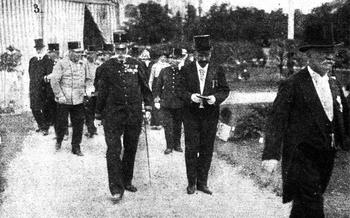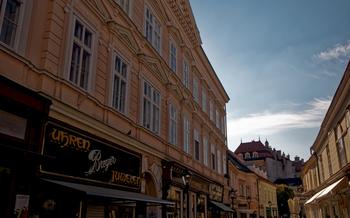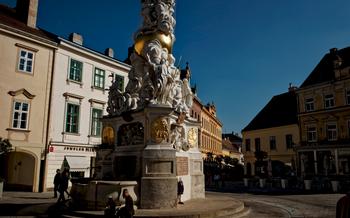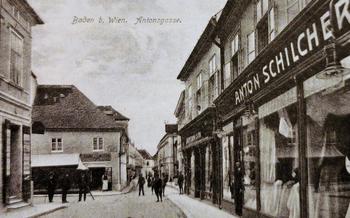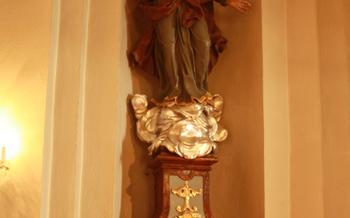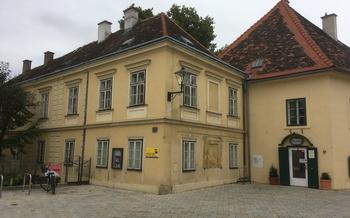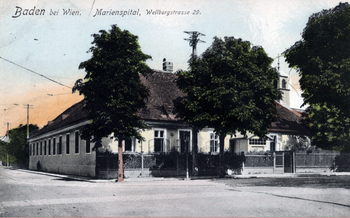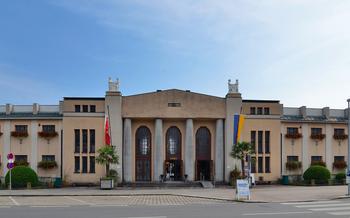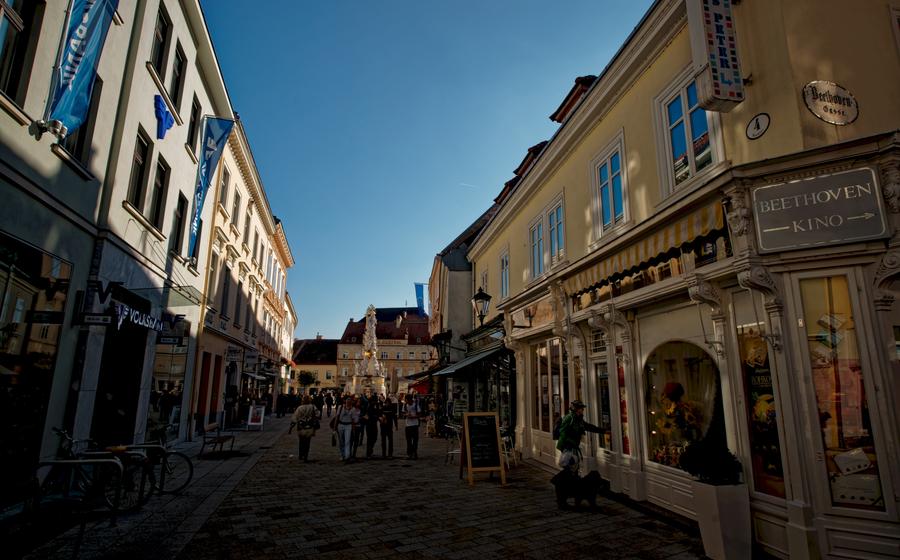
Plague Column
- Historical Significance:
- Architectural Marvel
- Location and Setting
- Religious Symbolism
- Artistic Masterpiece
- Historical Context:
- Local Traditions
- Legends and Myths
- Restoration and Preservation
- Symbol of Resilience
- Educational Resource
- Photographic Opportunities
- Souvenirs and Mementos
- Insider Tip:
Historical Significance:
The Plague Column in Baden bei Wien stands as a poignant reminder of a devastating chapter in the city's history. Erected in 1713, this monumental Baroque masterpiece commemorates the tragic loss of life during the Great Plague epidemic that swept across Europe in the 17th century. The column serves as a symbol of gratitude and remembrance for those who perished, a testament to the resilience of the human spirit in the face of adversity. Beyond its historical significance, the Plague Column is a stunning work of art, showcasing the exquisite craftsmanship and artistic vision of Johann Bernhard Fischer von Erlach, one of the most prominent Baroque architects of his time. Its intricate details and allegorical figures embody the Baroque style's exuberance and drama, making it a captivating spectacle for visitors from around the world.
Architectural Marvel
The Plague Column in Baden bei Wien stands as a magnificent testament to the skill and artistry of Baroque architecture and sculpture. Designed by the renowned architect Johann Bernhard Fischer von Erlach, the column boasts an intricate and awe-inspiring design.
The towering obelisk at the heart of the column is surrounded by a profusion of allegorical figures and reliefs, each meticulously carved to convey a specific message or symbol. The base of the column is adorned with four cherubs, symbolizing the four winds, while the shaft features reliefs depicting scenes from the Old Testament and the life of Christ.
One of the most striking features of the Plague Column is its use of iconography. The figures and reliefs are carefully arranged to tell a story of faith, hope, and redemption. At the top of the column, the figure of the Virgin Mary stands triumphant, representing the victory over the plague.
The Plague Column is a true masterpiece of Baroque art and architecture. Its intricate details, symbolic imagery, and harmonious proportions make it a must-see for anyone interested in art, history, or religion.
Location and Setting
Baden bei Wien, a picturesque spa town situated just south of Vienna, serves as the enchanting backdrop for the Plague Column. Located in the heart of the city, the column stands tall in the historic city center, surrounded by charming streets, lush parks, and tranquil thermal springs. Reaching Baden bei Wien is a breeze, with convenient public transportation options available from Vienna. Alternatively, a scenic drive through the picturesque countryside offers a delightful alternative. Upon arrival in Baden bei Wien, visitors can easily find the Plague Column, as it is a prominent landmark in the city center.
Religious Symbolism
The Plague Column holds immense religious significance, serving as a symbol of faith and devotion for the people of Baden bei Wien. It represents their unwavering belief in divine intervention and their gratitude for the protection they received during the devastating plague epidemic. The column is a testament to the deep-rooted Catholic faith of the community and its reliance on divine guidance in times of crisis.
Throughout the year, the Plague Column serves as a focal point for religious ceremonies and processions. On special occasions, such as the feast day of Saint Sebastian, the patron saint of plague victims, elaborate processions are held, where the faithful carry candles and pray for protection against future epidemics. These processions are a powerful reminder of the community's enduring faith and their gratitude for the column's symbolic presence.
Legends and stories abound, attributing miraculous powers to the Plague Column. It is said that those who pray before the column with a pure heart and unwavering faith may have their prayers answered. Tales of miraculous healings and answered prayers have been passed down through generations, further solidifying the column's status as a symbol of hope and divine intervention.
The Plague Column stands as a reminder of the power of faith and the resilience of the human spirit in the face of adversity. It is a symbol of hope and a source of comfort for those who seek solace and guidance in times of need.
Artistic Masterpiece
The Plague Column is not only a religious and historical monument but also a remarkable work of art. Designed by Johann Bernhard Fischer von Erlach, a prominent Baroque architect, the column showcases intricate details and craftsmanship that are characteristic of the Baroque style. Constructed from marble, bronze, and gold, the column features a towering obelisk surrounded by allegorical figures and reliefs. These figures represent various saints, virtues, and the triumph over disease, creating a visually stunning and symbolic composition.
The column's intricate carvings and sculptures demonstrate the skill and artistry of the craftsmen involved in its creation. The expressive faces, flowing draperies, and dynamic poses of the figures add depth and emotion to the column, making it a true masterpiece of Baroque art. Visitors can spend hours admiring the intricate details and symbolism depicted on the column, gaining a deeper appreciation for the artistry and craftsmanship of the Baroque period.
Historical Context:
The plague pandemic that swept across Europe in the 17th century left an indelible mark on the people of Baden bei Wien. The city's population was decimated, with thousands falling victim to the deadly disease. The Plague Column stands as a poignant reminder of this tragic chapter in history, serving as a testament to the suffering and resilience of the community.
The plague arrived in Baden bei Wien in 1679, brought by soldiers returning from the front lines of the Thirty Years' War. The disease quickly spread through the city's narrow streets and crowded living conditions, claiming the lives of young and old alike. The city's medical infrastructure was overwhelmed, and there was no known cure for the plague.
In the face of such devastation, the people of Baden bei Wien turned to their faith for solace and support. They prayed for divine intervention and vowed to erect a monument to commemorate the victims of the plague if the city was spared. Their prayers were answered, and the plague eventually subsided.
The Plague Column was commissioned in 1713 as a tangible expression of gratitude and remembrance. Designed by Johann Bernhard Fischer von Erlach, the column's elaborate iconography reflects the religious and cultural beliefs of the time. It stands as a powerful reminder of the fragility of life, the importance of faith, and the resilience of the human spirit in the face of adversity.
Local Traditions
The Plague Column is deeply embedded in the local traditions and customs of Baden bei Wien. Each year, on the Feast of the Assumption of Mary, a solemn procession winds its way through the streets of the town, culminating at the column. The procession, attended by hundreds of devout Catholics, is a testament to the enduring faith and gratitude of the community.
Another local tradition associated with the Plague Column is the "Pestsäule-Waschen", or the washing of the column. This ritual takes place annually on the second Sunday of September. During the ceremony, the column is meticulously cleaned and adorned with fresh flowers by members of the local community. The washing of the column is a symbolic act of purification and renewal, representing the community's ongoing commitment to remembering and honoring the victims of the plague.
Legends and Myths
The Plague Column is shrouded in a rich tapestry of legends and myths that have been passed down through generations. One captivating tale speaks of a young woman named Maria who was stricken with the plague. In her desperation, she prayed fervently to the column, promising to dedicate her life to serving others if she were to be spared. Miraculously, Maria recovered and, true to her word, she devoted her life to caring for the sick and needy.
Another legend tells of a group of travelers who were caught in a fierce storm while passing through Baden bei Wien. Seeking shelter, they stumbled upon the Plague Column and prayed for protection. As if by divine intervention, the storm suddenly subsided, and the travelers were able to continue their journey safely.
These legends and myths not only add to the allure of the Plague Column but also serve as a testament to the deep faith and resilience of the local people. The column has become a symbol of hope, reminding visitors and residents alike that even in the darkest of times, miracles can occur.
Restoration and Preservation
Over the centuries, the Plague Column has undergone several meticulous restoration and preservation efforts to ensure its longevity and historical integrity. The first significant restoration took place in the 18th century, when the column was cleaned and repaired after suffering damage from weathering and neglect. In the 19th century, a more comprehensive restoration was undertaken, involving the replacement of some of the sculptures and the addition of new gilding.
In the 20th century, the Plague Column faced new challenges, primarily due to air pollution and the effects of time. A major restoration project was initiated in the 1970s, which involved cleaning and repairing the column, as well as replacing some of the sculptures that had been damaged beyond repair. This extensive restoration aimed to restore the column to its original glory and ensure its preservation for future generations.
Today, the Plague Column stands as a testament to the dedication and skill of the artisans and conservators who have worked tirelessly to preserve this iconic landmark. Regular maintenance and monitoring are carried out to address any signs of deterioration and ensure that the column continues to grace the city of Baden bei Wien for centuries to come.
Symbol of Resilience
The Plague Column stands as a powerful symbol of resilience and triumph over adversity. It serves as a reminder of the strength and determination of the human spirit in the face of immense suffering and loss. The column's enduring presence speaks to the ability of communities to overcome tragedy and rebuild their lives.
Throughout history, people from all walks of life have found inspiration and hope in the Plague Column. Its intricate carvings and towering obelisk convey a sense of strength, resilience, and unwavering faith. Stories abound of individuals who have been touched by the column's presence, finding solace, comfort, and the courage to persevere through their own trials and tribulations.
One such story is that of a young woman named Anna, who lost her entire family to the plague. In her grief, she turned to the Plague Column for comfort and guidance. She would often sit at the base of the column, praying for strength and healing. Over time, Anna found the courage to rebuild her life, dedicating herself to helping others who had suffered loss. She became a nurse, tending to the sick and offering solace to those in need.
The Plague Column continues to inspire and uplift visitors to this day, reminding them of the power of hope, resilience, and the indomitable spirit of humanity.
Educational Resource
The Plague Column serves as a valuable educational resource, offering a tangible connection to history, art, religion, and culture. It provides an opportunity for students of all ages to learn about the devastating impact of the plague, the Baroque artistic movement, and the resilience of the human spirit. Teachers can incorporate the column into their curricula to teach about various subjects, including history, social studies, art history, and religious studies.
The column's intricate carvings and symbolism offer a rich source of material for classroom discussions and projects. By studying the column, students can gain insights into the beliefs and values of the people who lived during the 17th century. The column's survival through centuries of war, natural disasters, and social upheaval also serves as a testament to the enduring power of art and culture.
To enhance the educational experience, guided tours are available for groups of students. These tours provide expert insights into the column's history, symbolism, and restoration efforts. Teachers can also organize field trips to the column, allowing students to experience the monument firsthand and engage with its rich historical and artistic context.
Photographic Opportunities
The Plague Column is a photographer's dream, offering endless opportunities to capture its grandeur and intricate details. With its towering height and central location, the column dominates the skyline of Baden bei Wien, making it an iconic landmark for cityscape shots. For a unique perspective, try capturing the column from the picturesque alleys and courtyards that surround it, allowing you to frame the column against charming historical buildings.
The column's intricate sculptures and reliefs provide a wealth of subject matter for close-up photography. Zoom in on the expressive faces of the saints, the delicate drapery of their garments, and the symbolic animals and motifs that adorn the column. Experiment with different lighting conditions to enhance the play of shadows and highlights, creating dramatic and atmospheric images.
To capture the full majesty of the Plague Column, head to the nearby parks or gardens, such as the Kurpark or the Doblhoffpark. These vantage points allow you to step back and appreciate the column's scale and its harmonious relationship with the surrounding landscape. Whether you're a seasoned photographer or just starting out, the Plague Column is a subject that will challenge and inspire your creativity.
Souvenirs and Mementos
Preserving Memories and Sharing the Legacy
For those seeking a lasting memento of their visit to the Plague Column, a variety of souvenirs and collectibles are available. Souvenir shops in Baden bei Wien offer a range of items, including postcards featuring stunning images of the column, magnets to adorn your fridge, and miniature replicas that capture the intricate details of this Baroque masterpiece.
For a more substantial keepsake, consider purchasing a book or guide that delves deeper into the history, architecture, and symbolism of the Plague Column. These publications provide a wealth of information and insights, allowing you to continue learning about this remarkable monument long after your visit.
When choosing souvenirs, opt for high-quality items that will stand the test of time, ensuring that your memories of the Plague Column remain vivid for years to come. Whether you choose a postcard, magnet, replica, or book, these mementos will serve as tangible reminders of the beauty, history, and significance of this iconic landmark.
Insider Tip:
Venture beyond the Plague Column itself and explore the hidden underground chambers that lie beneath the monument. These chambers, once used for storage and shelter during times of war, are now accessible to the public through guided tours. Descend into the depths of history and discover a secret world of vaulted ceilings, stone walls, and echoes of the past. Uncover the forgotten stories of those who sought refuge within these subterranean realms, and gain a deeper appreciation for the resilience and resourcefulness of the human spirit.
